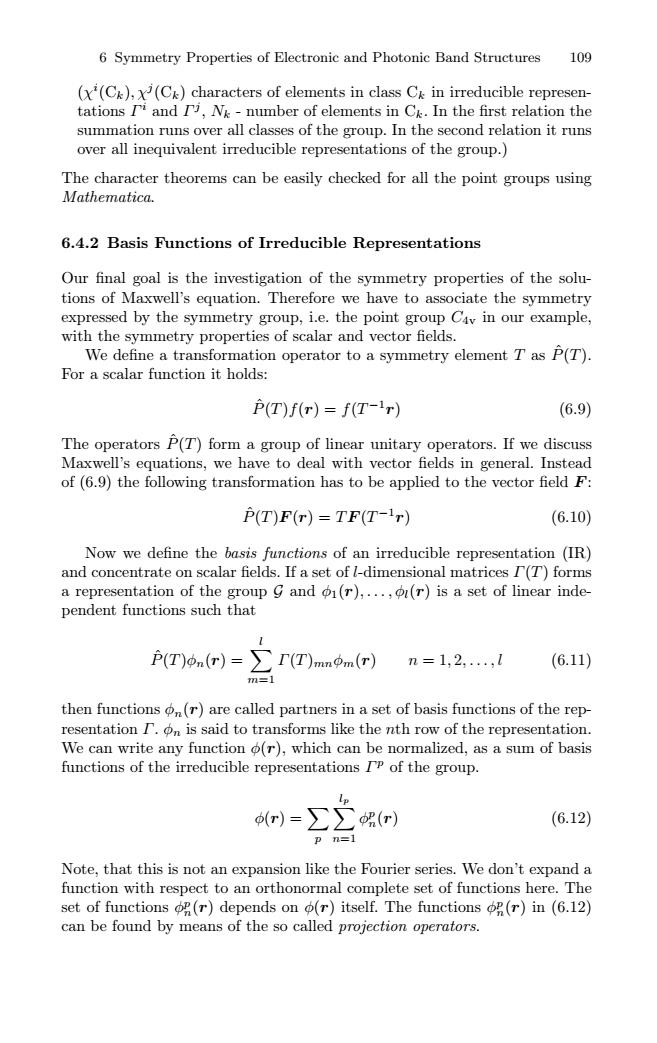正在加载图片...

6 Symmetry Properties of Electronic and Photonic Band Structures 109 (x(C),x(Ck)characters of elements in class Ck in irreducible represen- tations I and I,N&-number of elements in Ck.In the first relation the summation runs over all classes of the group.In the second relation it runs over all inequivalent irreducible representations of the group.) The character theorems can be easily checked for all the point groups using Mathematica. 6.4.2 Basis Functions of Irreducible Representations Our final goal is the investigation of the symmetry properties of the solu- tions of Maxwell's equation.Therefore we have to associate the symmetry expressed by the symmetry group,i.e.the point group Cav in our example, with the symmetry properties of scalar and vector fields. We define a transformation operator to a symmetry element T as P(T). For a scalar function it holds: P(T)f(r)=f(T-r) (6.9) The operators P(T)form a group of linear unitary operators.If we discuss Maxwell's equations,we have to deal with vector fields in general.Instead of(6.9)the following transformation has to be applied to the vector field F: P(T)F(r)=TF(T-r) (6.10) Now we define the basis functions of an irreducible representation (IR) and concentrate on scalar fields.If a set of l-dimensional matrices I(T)forms a representation of the group g and (r),...,o(r)is a set of linear inde- pendent functions such that P(T)pn(r)=∑T(T)mnm(r)n=l,2,,l (6.11) m=1 then functions on(r)are called partners in a set of basis functions of the rep- resentation T.on is said to transforms like the nth row of the representation. We can write any function o(r),which can be normalized,as a sum of basis functions of the irreducible representations I'P of the group. p (r)= (6.12) p n=l Note,that this is not an expansion like the Fourier series.We don't expand a function with respect to an orthonormal complete set of functions here.The set of functions o(r)depends on o(r)itself.The functions op(r)in (6.12) can be found by means of the so called projection operators.6 Symmetry Properties of Electronic and Photonic Band Structures 109 (χi (Ck), χj (Ck) characters of elements in class Ck in irreducible representations Γi and Γj , Nk - number of elements in Ck. In the first relation the summation runs over all classes of the group. In the second relation it runs over all inequivalent irreducible representations of the group.) The character theorems can be easily checked for all the point groups using Mathematica. 6.4.2 Basis Functions of Irreducible Representations Our final goal is the investigation of the symmetry properties of the solutions of Maxwell’s equation. Therefore we have to associate the symmetry expressed by the symmetry group, i.e. the point group C4v in our example, with the symmetry properties of scalar and vector fields. We define a transformation operator to a symmetry element T as Pˆ(T). For a scalar function it holds: Pˆ(T)f(r) = f(T −1r) (6.9) The operators Pˆ(T) form a group of linear unitary operators. If we discuss Maxwell’s equations, we have to deal with vector fields in general. Instead of (6.9) the following transformation has to be applied to the vector field F: Pˆ(T)F(r) = TF(T −1r) (6.10) Now we define the basis functions of an irreducible representation (IR) and concentrate on scalar fields. If a set of l-dimensional matrices Γ(T) forms a representation of the group G and φ1(r),...,φl(r) is a set of linear independent functions such that Pˆ(T)φn(r) = l m=1 Γ(T)mnφm(r) n = 1, 2,...,l (6.11) then functions φn(r) are called partners in a set of basis functions of the representation Γ. φn is said to transforms like the nth row of the representation. We can write any function φ(r), which can be normalized, as a sum of basis functions of the irreducible representations Γp of the group. φ(r) = p lp n=1 φp n(r) (6.12) Note, that this is not an expansion like the Fourier series. We don’t expand a function with respect to an orthonormal complete set of functions here. The set of functions φp n(r) depends on φ(r) itself. The functions φp n(r) in (6.12) can be found by means of the so called projection operators